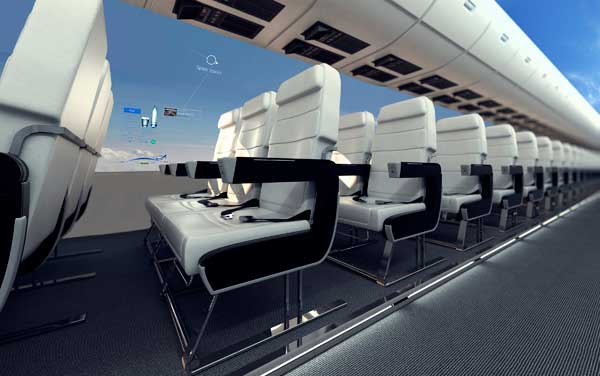
[Image above] The Center for Process Innovation’s windowless fuselage features no windows but comes with an extraordinary view. Credit: Center for Process Innovation
I attended the 75th Conference on Glass Problems recently (read the recap here), and based on what I heard (and what you already likely know), one of glass’s problems just happens to be the need for its further and more flexible application in consumer electronics (CE).
Michael Pambianchi, research director of Glass Research at Corning Incorporated, knows this just as well as anyone, and his talk during the meeting’s Glass Melting Session focused on issues with developing these flexible, thin devices while maintaining strength.
He mentioned the rollup devices and curved screens currently in the works by CE giants Samsung and LG, which has developed a rollable OLED TV panel.
OLEDs are popping up everywhere, like in this tri-fold touchscreen for smartphones, and are certain to be big news at the International Consumer Electronic Show in Las Vegas this coming January, but these displays could also find a home in the airplanes of the future.
That’s right—20 or 30 years from now, your flight may feature a windowless fuselage.
The United Kingdom’s Center for Procession Innovation’s (CPI) vision of planes-to-come includes “a cabin where the windows are display screens, relaying a choice of views from around the aircraft” and provides in-flight entertainment by way of the enormous seat-back display. READ: Aisle or window will make little difference in 2034.

Credit: Center for Process Innovation
“Screens that are ultra thin, very light, and highly flexible are integrated with the fuselage or the seat backs with no unsightly, clumsy, or heavy housings,” states CPI’s website.
And every pound counts on a plane. According to the Center, more than 80 percent of the weight of each airliner is the aircraft itself. A weight reduction of 1 percent equals a fuel-cost savings of 0.75 percent, and less fuel means less CO2.
CPI is quick to note that the windowless airliner is in concept stage—but what a concept it is.

Credit: Center for Process Innovation
Using roll to roll manufacturing that is as continuous as it is cost-effective, their 150 dpi full-color displays are designed to last a lifetime, or, at the very least, the aircraft’s lifetime (roughly 20,000 hours). I’ll let CPI tell it (since they tell it best):
“The entire inner surface of the fuselage—or selected sections—can be covered with thin high-definition, flexible displays screens onto the fuselage: either directly, or onto modular lining panels that can be used to conceal cabin utilities. This ‘multi screen’ approach means that panels can be used either as displays or for lighting, depending upon the cabin seating layout and seat pitches. This arrangement also has advantages over a single long screen running the length of the fuselage as any display faults could result in the removal of the virtual windows and lighting from an entire side of the aircraft, where the electrical losses in the system would be significant. Another advantage in this arrangement is that the system offers more flexibility in correcting the displayed images for parallax; this will increase the sensation of looking out of a window, rather than looking at a projected image. Internal tracking cameras could be used to project the image onto the screen from the point of view of the passenger—moving the image in accordance with the movements of the passenger’s head.
Images would be relayed from a series of cameras mounted on the fuselage, potentially giving each display an uninterrupted view of the exterior (avoiding the wings and engines). Users in any seat will be able to select views from any side of the aircraft. It would not be necessary to reflect the actual view seen from a particular seat, so the cameras could be mounted in the most aerodynamically efficient positions on the aircraft. The lighting panels would allow the colour changes associated with sunrise and sunset to be controlled on long haul journeys, helping passengers to adjust to time zone differences.”
But, as with any new technology, further design, development, and testing are needed to make these hi-def dreams a reality.
In an email, CPI’s Steven Bagshaw writes, “We believe fully flexible OLED technology at a scale able to be used in the aerospace market will be available in approximately 10 years, but the aviation industry works 10–20 years ahead in terms of design; therefore, the concept shown in the video will not become a reality for at least 20–30 years (not 10 years as stated in some outlets).”

Credit: Center for Process Innovation; YouTube
Author
Jessica McMathis
CTT Categories
- Aeronautics & Space
- Electronics
- Energy
- Manufacturing
- Material Innovations
- Transportation


